名前を赤で表記しているメンバーは当研究室の学生・院生、青で表記しているメンバーは当研究室の教員です。
原著論文
- Mohan Gopalakrishnan, Mohamad Etesami, Jayaraman Theerthagiri, Myong Yong Choi, Suttipong Wannapaiboon, Mai Thanh Nguyen, Tetsu Yonezawa and Soorathep Kheawhom “Tailoring MOF structure via ligand optimization achieved dandelion flower like CoS/Co-Nx/CoNi/NiS catalyst to enhance ORR/OER for zinc-air batteries”
Nanoscale, 14(48), 17908-17920 (2022).【RSC】【Open Access】(IF=8.307)
DOI: 10.1039/D2NR04933C (Published (web) 7 Novembeer 2022)Abstract: Due to their affordability and good catalytic activity for oxygen reactions, MOF-derived carbon composites containing metal alloys have piqued interest. However, during synthesis, MOFs have the disadvantage of causing significant carbon evaporation, resulting in a reduction of active sites and durability. This study proposes tailoring the molecular structure of MOFs by optimizing bipyridine and flexible 4-aminodiacetic terephthalic acid ligands, which have numerous coordination modes and framework structures, resulting in fascinating architectures. MOF frameworks having optimized N and O units are coordinated with Co and Ni ions to provide MOF precursors that are annealed at 700 °C in argon. The MOF-derived Co9S8/Co-Nx/CoNi/Ni3S2@CNS-4 catalyst exhibits excellent catalytic activity, revealing ORR half-wave potential 0.86 V, and overpotential (OER) 196 mV at 10 mA cm-2, a potential gap of 0.72 V and a Tafel slope of 79 mV dec-1. The proposed strategy allows for the rational design of N coordinated Co and CoNi alloys attached to ultra-thin N, S co-doped graphitic carbon sheets to enhance bifunctional activity and sufficient active sites. Consequently, the zinc-air battery using the synthesized catalyst shows a high peak power density of 206.9 mW cm-2 (Pt/C+RuO2 116.1 mW cm-2), a small polarization voltage of 0.96 V after 370 h at 10 mA cm-2, and outstanding durability of over 2400 cycles (400 h). The key contributions to the superior performance are the synergetic effects of the CoNi alloys plus the N, S-incorporated carbon skeleton, due to the small charge transfer resistances and enhanced active sites of CoNi, metal-S, and pyridinic-N.
- Mingbei Zhu, Mai Thanh Nguyen, Wei Jian Sim, and Tetsu Yonezawa
“Co-sputtered CuPt/Ag alloy nanoparticles and comparative catalytic performance of mono-, bi-, and tri-metallic nanoparticles in oxygen reduction reaction”
Materials Advances, 3(24), 8967-8976 (2022). 【RSC】【Open Access】
DOI: 10.1039/D2MA00688J (Published (web) 11 October 2022)

Abstract: CuPt/Ag trimetallic alloy nanoparticles (NPs) were synthesized by co-sputtering onto liquid polyethylene glycol (PEG), using a CuPt alloy target and an Ag target. The fine structure analysis reveals that the obtained NPs are trimetallic solid solution alloys. Ag compositions increased with the increase of sputtering currents applied to an Ag target while keeping the sputtering currents applied to CuPt target constant. Moreover, it was found that the Cu : Pt atomic ratios of single NPs measured by energy dispersive spectroscopy (EDS) coupled with scanning transmission electron miscroscopy (STEM) were lower than the average value of the sputtered NPs dispersed in PEG. This suggests that NPs which are big enough to be checked by STEM-EDS are mainly Pt-rich NPs. The Cu, Ag, and Pt compositions of trimetallic NPs varied in a wide range, indicating random alloy formation. The sputtered trimetallic CuPt/Ag NPs were studied as catalysts in the oxygen reduction reaction (ORR), and the catalytic performance is compared with sputtered bimetallic alloy Cu/Pt and Ag/Pt NPs and monometallic Pt NPs. Trimetallic CuPt/Ag NPs showed higher ORR catalytic activities than bimetallic alloy Cu/Pt NPs owing to their better stability and dispersibility on the carbon support. However, the trimetallic alloy NPs performed worse than bimetallic Ag/Pt NPs and Pt NPs. This is caused by Cu oxidation and dissolution of Pt and Cu. Comparable ORR catalytic peformance of Ag/Pt NPs (40 atom% Ag) with Pt NPs is thought to come from the synergy between Pt and Ag in the bimetallic alloy.
- 浅野ちひろ,高橋唯仁,春藤晃人,伊藤新次,米澤 徹
「薄膜旋回型攪拌技術を利用したTiO2分散による紫外線遮蔽効果の顕著な改善」
日本化粧品技術者会誌,56(3), 281-289 (2022).
Chihiro Asano, Tadahito Takahashi, Akihito Shindo, Shinji Ito, and Tetsu Yonezawa
“Distinct Improvement in UV Light Protection Properties by TiO2 Dispersion Using a Thin Film Spinning Technique”
Journal of the Society of Cosmetic Chemists, Japan, 56(3), 281-289 (2022).
DOI: 10.5107/sccj.56.281 (Published 20 September 2022)
【産学連携】
アブストラクト:ナノメートル領域の直径をもつ酸化チタン(TiO2)や酸化亜鉛(ZnO)の無機微粒子は,透明性や紫外線(UV)防御などの優れた光学特性をもつため,サンケア製品を中心として化粧品業界にも幅広く活用されている。しかしながら,ナノレベルの超微粒子はその大きな表面エネルギーのために製剤中で二次凝集を形成し,製品の機能を低下させる要因となっている。そこで本研究では,それらの凝集状態を解消するべく最適な製造プロセスの検討を試みた。新しいプロセスとして薄膜旋回型高速攪拌機をTiO2微粒子の分散に利用し,サンケア製品に関わる各種特性にどのような影響を及ぼすかを検討した。その結果,微粒子酸化チタンの分散において周速の増加に伴って単分散を示すシャープな粒度分布となると同時に,分光光度計で測定した紫外線透過率との相関が認められた。さらに,W/O,O/Wの2種類のクリーム状サンケア製剤を調製し,紫外線防御指数(SPF)をSPFアナライザーで測定したところ,散乱剤の凝集が効果的に解砕されていることとSPF値の増加に相関がみられ,特に周速30m/s以上の速度で調製したものでは,SPF値の顕著な増加が確認され,紫外線吸収剤を含まないノンケミカル処方,かつ5 wt%という低い散乱剤濃度にもかかわらず,SPF30に近い値を示した。これらの結果は,サンケア製品の機能性の向上に分散機の条件が寄与することを意味し,機能性製品における攪拌プロセスの重要性が示されたので,ここに報告する。
- Haoran Liu, Naoki Miyamoto, Mai Thanh Nguyen, Hiroki Shirato, and Tetsu Yonezawa
“Injectable fiducial marker for image-guided radiation therapy based on gold nanoparticles and a body temperature-activated gel-forming system”
ACS Applied Bio Materials, 5(10), 4838-4848 (2022).【ACS】
DOI: 10.1021/acsabm.2c00566 (Published (web) 8 September 2022)
【学内学部間共同研究】【医工連携】【JKA】【ノーステック】【AMED】
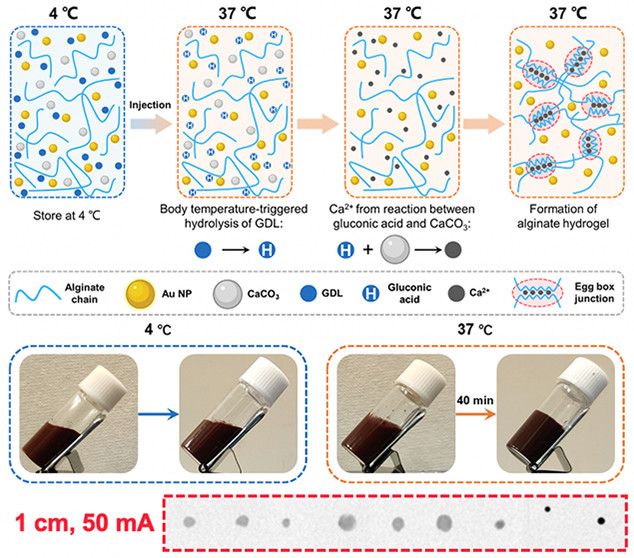
Abstract: Injectable fiducial markers are crucial in image-guided radiation therapy (IGRT) due to their minimally invasive operations and improved patient compliance. This study presents the development of a ready-to-use injectable fiducial marker utilizing alginate stabilized-gold nanoparticles (alg-Au NPs) and a body temperature-activated in situ gel-forming system. Gram-scale alg-Au NPs were prepared in an hour by a green microwave-induced plasma-in-liquid process (MWPLP). Sodium alginate was introduced in this process to avoid aggregation between Au NPs, which ensured their stability and injectability. The gelation behavior of alginate with divalent cations and a temperature-dependent release of calcium source (glucono-delta-lactone (GDL) and CaCO3) served as the foundation of the body temperature-activated in situ gel-forming system. The injectable fiducial marker GDL/CaCO3/alg-Au NPs could maintain a liquid state at a low temperature for a higher injectability. After injection, on the other hand, Ca2+ would be released due to the body temperature-activated hydrolysis of GDL and the subsequent reaction with CaCO3, which would initiate the gelation of alginate. The injectable fiducial marker can be therefore delivered via injection and form gel at target site to avoid marker movement or Au NPs leakage after injection. Rheological measurements demonstrate the stability and gelation behavior of GDL/CaCO3/alg-Au NPs at different temperatures. Furthermore, the injectability and imaging ability of GDL/CaCO3/alg-Au NPs were also examined. In summary, ready-to-use injectable fiducial marker GDL/CaCO3/alg-Au NPs were developed via a green and facile method for IGRT.
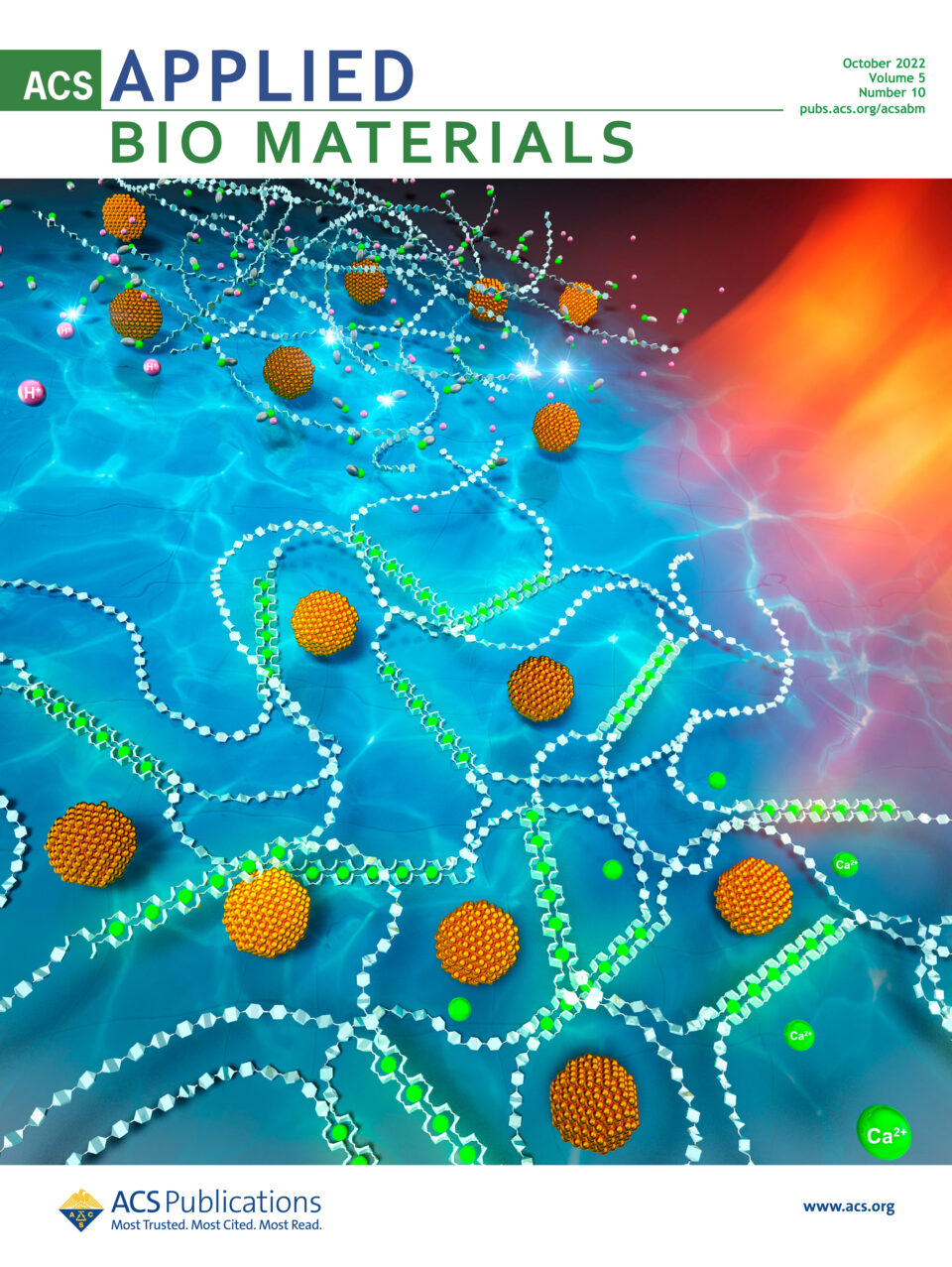
- Ikumi Akita, Yohei Ishida, and Tetsu Yonezawa
“Mixed Metal-Atom Markers Enable Simultaneous Imaging of Spatial Distribution in Two-Dimensional Heterogeneous Molecular Assembly by Scanning Transmission Electron Microscopy”
ACS Measurement Science Au, 2(6), 542-526 (2022). 【ACS】【Open Access】
DOI:10.1021/acsmeasuresciau.2c00043 (Published (web) 3 Augst 2022)
【研究室内研究】
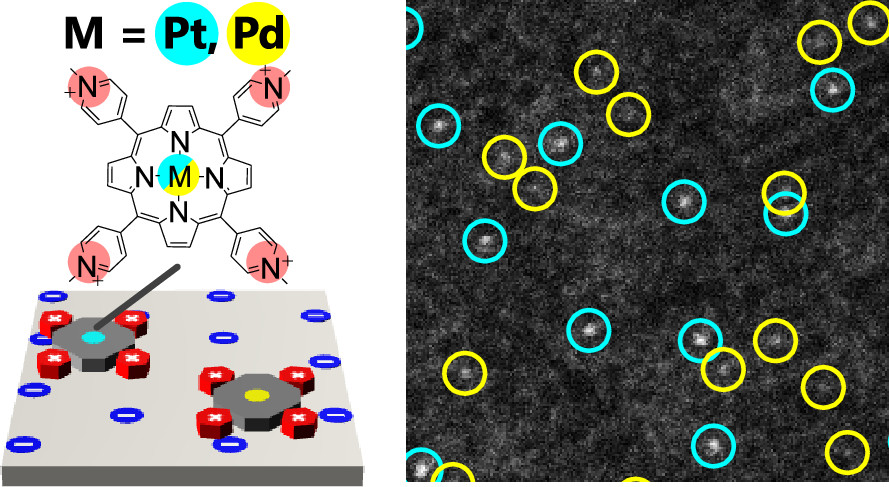 Abstract: Atomic-scale observation by aberration-corrected scanning transmission electron microscopy (STEM) is essential for characterizing supramolecular assemblies with nonperiodic structures. Identifying the relative spatial arrangement in a mixture of molecular species in an assembly is crucial for understanding chemical reaction systems occurring in the assembly. Herein, we report the first direct observation of supramolecular assemblies comprising anionic clay mineral nanosheets and two types of cationic porphyrin complexes with Pt and Pd atom markers by annular dark-field STEM, enabling the simultaneous imaging of well-mixed spatial molecular distributions. The results expand the possibility of applying electron microscopy to self-assembly structures constructed via weak supramolecular interactions on relatively thick nanosheet materials and on one- to few-atom-thick graphene analogues, which will provide important guidelines for future material design.
Abstract: Atomic-scale observation by aberration-corrected scanning transmission electron microscopy (STEM) is essential for characterizing supramolecular assemblies with nonperiodic structures. Identifying the relative spatial arrangement in a mixture of molecular species in an assembly is crucial for understanding chemical reaction systems occurring in the assembly. Herein, we report the first direct observation of supramolecular assemblies comprising anionic clay mineral nanosheets and two types of cationic porphyrin complexes with Pt and Pd atom markers by annular dark-field STEM, enabling the simultaneous imaging of well-mixed spatial molecular distributions. The results expand the possibility of applying electron microscopy to self-assembly structures constructed via weak supramolecular interactions on relatively thick nanosheet materials and on one- to few-atom-thick graphene analogues, which will provide important guidelines for future material design. - Durai Govindarajan, Nithyadharseni Palaniyandy, Karthik Kumar Chinnakutti, Mai Thanh Nguyen, Tetsu Yonezawa, Jiaqian Qin, and Soorathep Kheawhom
“Sputter Deposited Binder-Free Nanopyramidal Cr/γ-Mo2N TFEs for High Performance Supercapacitors”
Nanoscale Research Letters,17, 65 (2022).【Springer】(IF=4.703)
DOI: 10.1186/s11671-022-03704-5 (Published 19 July 2022)
【海外共同研究】
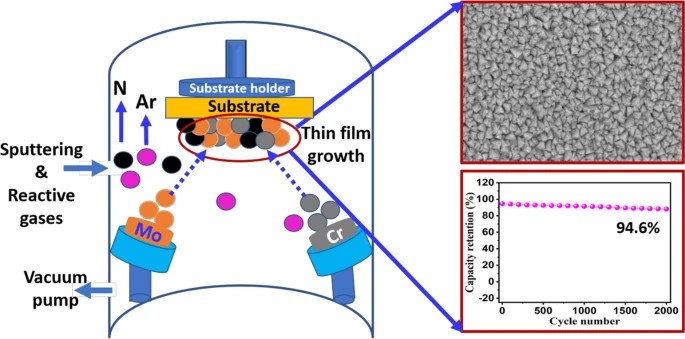
Abstract: Due to their outstanding power density, long cycle life and low cost, supercapacitors have gained much interest. As for supercapacitor electrodes, molybdenum nitrides show promising potential. Molybdenum nitrides, however, are mainly prepared as nanopowders via a chemical route and require binders for the manufacture of electrodes. Such electrodes can impair the performance of supercapacitors. Herein, binder-free chromium (Cr)-doped molybdenum nitride (Mo2N) TFEs having different Cr concentrations are prepared via a reactive co-sputtering technique. The Cr-doped Mo2N films prepared have a cubic phase structure of γ-Mo2N with a minor shift in the (111) plane. While un-doped Mo2N films exhibit a spherical morphology, Cr-doped Mo2N films demonstrate a clear pyramid-like surface morphology. The developed Cr-doped Mo2N films contain 0–7.9 at.% of Cr in Mo2N lattice. A supercapacitor using a Cr-doped Mo2N electrode having the highest concentration of Cr reveals maximum areal capacity of 2780 mC/cm2, which is much higher than that of an un-doped Mo2N electrode (110 mC/cm2). Furthermore, the Cr-doped Mo2N electrode demonstrates excellent cycling stability, achieving ~ 94.6% capacity retention for about 2000 cycles. The reactive co-sputtering proves to be a suitable technique for fabrication of binder-free TFEs for high-performance energy storage device applications.
- Mohammad Etesami, Ramin Khezri, Ali Abbasi, Mai Thanh Nguyen, Tetsu Yonezawa, Soorathep Kheawhom, Anongnat Somwangthanaroj
“Ball mill-assisted synthesis of NiFeCo-NC as bifunctional oxygen electrocatalysts for rechargeable zinc-air batteries”
Journal of Alloys and Compounds, 922, 166287 (2022). (11pp.)【Elsevier】(IF=6.371)
DOI : 10.1016/j.jallcom.2022.166287(Published (web) 12 July 2022)
【海外共同研究】
Highlights: •Catalysts based on trimetallic NiFeCo nanoparticles distributed over a CNT-graphene-like (NiFeCo-NC) structure.
•A simple and cost-effective ball milling method for synthesis of NiFeCo-NC catalysts.
•NiFeCo-NC catalysts revealed reliable performances as a bifunctional OER- ORR catalyst.
•A long-term cycling stability in rechargeable Zn-air battery was confirmed.
•NiFeCo-NC catalyst exhibited excellent methanol tolerance.
Abstract: Oxygen reduction reaction (ORR) and oxygen evolution reaction (OER) are the core of clean energy technology. Oxygen electrocatalysts based on earth-abundant metals are of prime importance. Trimetallic catalysts have demonstrated reliable activities but their average performance, difficult synthesis techniques, and high synthesis costs limit their widespread use. Herein, the facile ball milling technique is introduced as an efficient and low-cost method for the synthesis of catalysts based on trimetallic NiFeCo nanometer-scale particles distributed over a CNT-graphene-like (NiFeCo-NC) structure. NiFeCo-NC is synthesized instantaneously from ball milling of melamine with industrial carbon nanotubes (CNTs) along with trimetallic particles. Results demonstrate that the NiFeCo-NC2 catalyst, synthesized from 2 g of melamine per 1 g of each metal salt, performed well in both ORR and OER. The potential difference between the half-wave reduction potential of the ORR (E1/2) and the oxidation potential at 10 mA cm−2 (E10) in OER reveals a better performance of the NiFeCo-NC2 as a bifunctional catalyst than other synthesized materials and reference catalysts. A zinc-air battery (ZAB) having the NiFeCo-NC2 catalyst performs better than the batteries using other catalysts. The NiFeCo-NC2 catalyst also exhibits excellent methanol tolerance, revealing its applicability for direct methanol fuel cell (DMFC) applications. Ball milling offers a simple, effective, versatile, and cost-effective mechano-chemical procedure for the concomitant one-pot mixing-synthesis of materials.
- Zixuan Huang, Mai Thanh Nguyen, Wei Jian Sim, Masayuki Takahashi, Soorathep Kheawhom, Tetsu Yonezawa
”CoxNi1-xO-NiCo2O4/rGO Synergistic Bifunctional Electrocatalysts for High-Rate Rechargeable Zinc-Air Battery”
Sustainable Energy & Fuels, 6(17), 3931-3943 (2022).【RSC】(IF=6.367)
DOI: 10.1039/D2SE00606E (Published (web) 20 June 2022)
【海外共同研究】【JST】

Abstract: Bifunctional catalysts containing spinel NiCo2O4 and CoxNi1−xO bimetallic oxide nanoparticles embedded on reduced graphene oxide (rGO), CoNi/rGO, were obtained by the thermal decomposition of metal nitrates and graphene oxide (GO). For the first time, we report the correlation of the catalytic activities in the oxygen reduction reaction (ORR) and oxygen evolution reaction (OER) at low current density (<30 mA cm−2) and the zinc–air battery (ZAB) performance at a high current density of 100 mA cm−2 with the structures of CoNi/rGO catalysts with different Co : Ni molar ratios and metal loading. A layer of 2–3 nm NiCo2O4 and Co-rich CoxNi1−xO nanoparticles on rGO exhibited a synergistic ORR catalytic effect. In contrast, NiO and big-sized Ni-rich CoxNi1−xO nanoparticles (10–20 nm) exhibited poor ORR and OER performance at low current density. No synergetic effect of Co and Ni oxides were found in the OER at low current density in the electrochemical test. The battery test at high current density revealed the best cycling stability of CoNi/rGO-5/5 with equimolar Co and Ni and medium metal loading. This is due to the synergetic OER performance with the lowest charge voltage at high current density and the best ORR activity with the highest electron transfer numbers of 3.63. This is related to the highest Co : Ni ratio of the small-sized CoxNi1−xO bimetallic oxide and the high amount of spinel NiCo2O4 nanoparticles. Corrosion during charging was found to be the limiting factor of the long-term cycling stability at high current density.
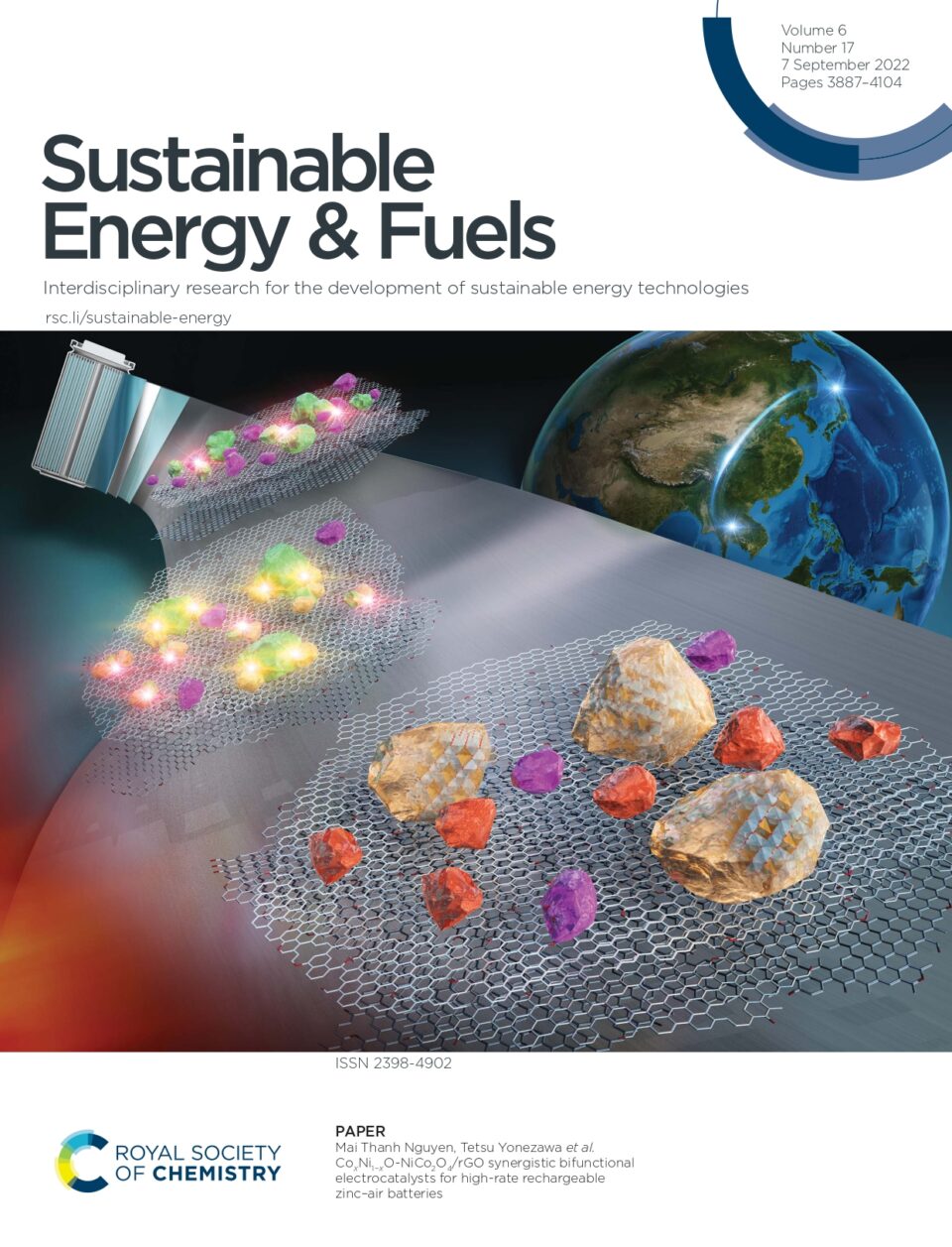
- Hideya Kawasaki,* Tomoko Otsuki, Fumiya Sugino, Ken Yamamoto, Tomoharu Tokunaga, Rintaro Tokura, and Tetsu Yonezawa*
“Liquid metal catalyst for the conversion of ethanol into graphitic carbon layers under ultrasonic cavitation field”
Chemical Communications, 58(56), 7741-7744 (2022).【RSC】(IF=6.222)
DOI: 10.1039/D2CC02510H (Published (web) 13 June 2022)
【大学間共同研究】
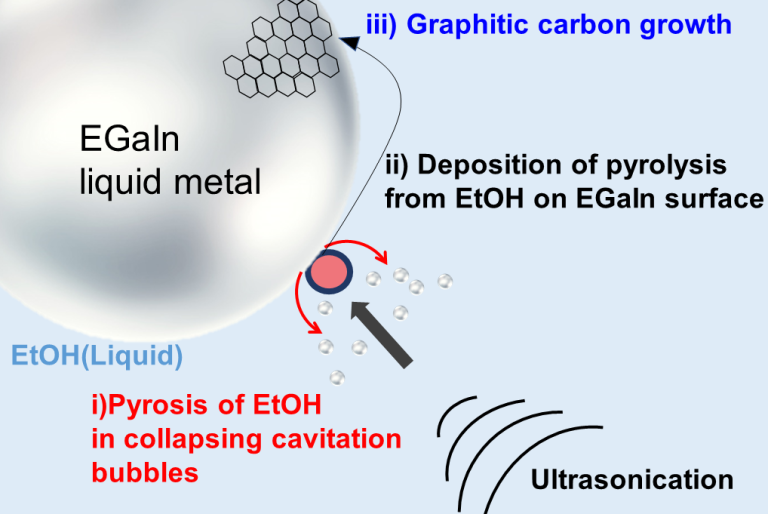
Abstract: Eutectic Gallium Indium (EGaIn) has drawn considerable research interest in potential liquid catalysis. Herein, we report that EGaIn liquid metal acts as a catalyst for the growth of graphitic carbon layer from ethanol under ultrasonication. High-speed imaging demonstrated the formation of ultrasonic cavitation bubbles at the liquid metal/ethanol interface, which facilitated the pyrolysis of ethanol into graphitic carbon on the liquid metal surface.
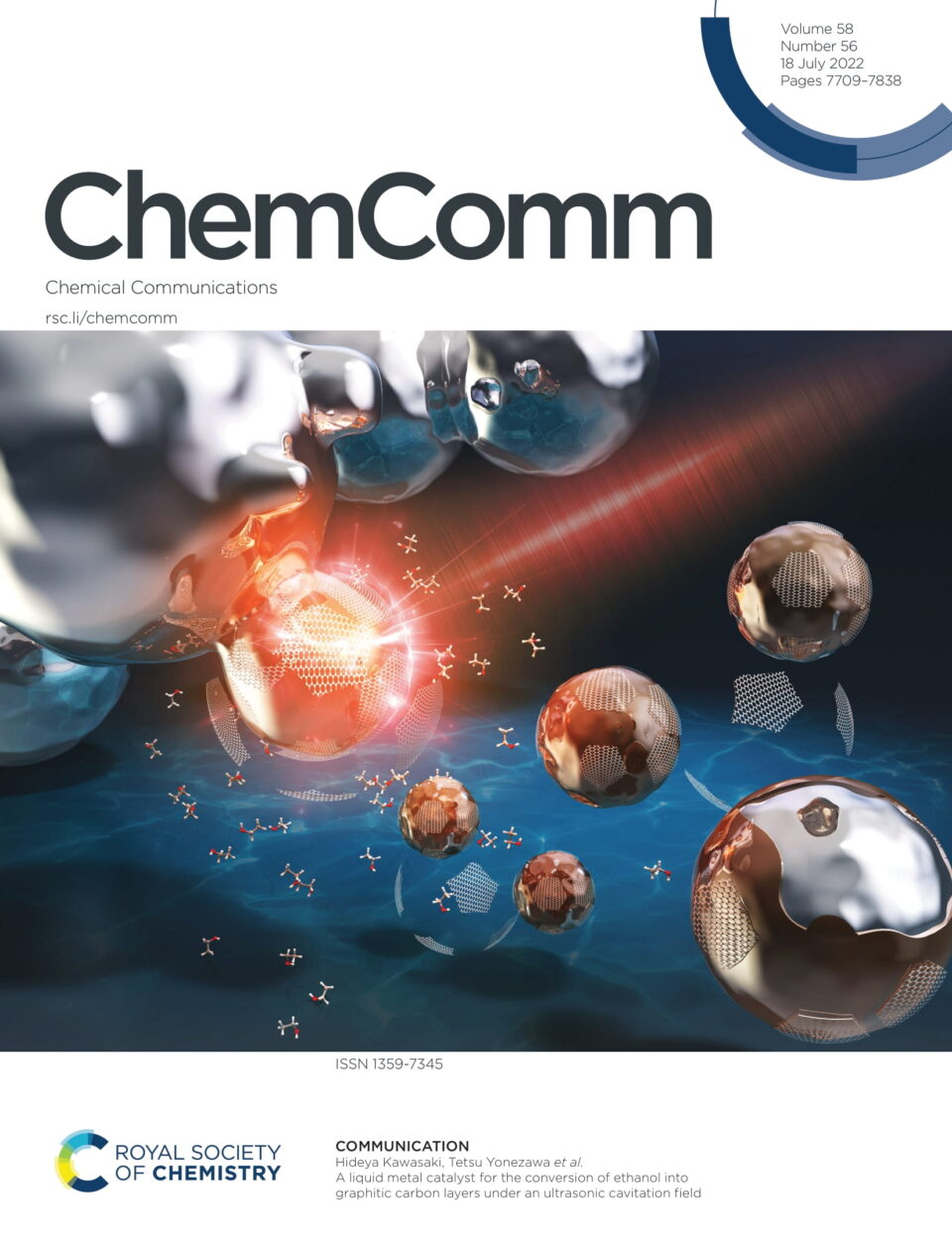
- Mohammad Etesami, Mai Thanh Nguyen, Tetsu Yonezawa, Adisorn Tuantranont, Anongnat Somwangthanaroj, Soorathep Kheawhom【Review Article】
“3D Carbon nanotubes-graphene hybrids for energy devices”
Chemical Engineering Journal, 446(3), 137190 (2022).
DOI: 10.1016/j.cej.2022.137190 (Published (web) 25 May 2022). (IF = 13)
【国際共同研究】【JST】
Abstract: Due to the global concerns on limited non-renewable energy resources, developing accessible renewable energy systems and expanding electrochemical energy-related devices are serious necessities. Recently, carbon-based metal-free materials have played a crucial role in electrochemical devices. Carbon-based metal-free electrocatalysts have been recognized as proper alternatives for the replacement of frequently used Pt in these devices. Carbon nanotubes-graphene (CNTs-G) hybrids are three-dimensional (3D) carbonaceous structures that have attracted researchers’ interest in the last decade. Because of the unique properties of sp2-hybridized carbon nanostructures viz. superb mechanical, electrical, and catalytic performances, plus recent extensive applications in various aspects, CNTs and graphene families are considered prospective heterostructure materials for next-generation technologies. Moreover, carbon-based materials have demonstrated excellent performance in key reactions like oxygen reduction reaction (ORR), oxygen evolution reaction (OER), and hydrogen evolution reaction (HER) that occur on the surface of catalysts or electrodes in electrochemical energy conversion/storage devices. The ability to accept functional groups and dopants, create defects, present a large surface area, high porosity, and superior electrolyte penetration, facilitate ion transport, accelerate charge transfer, and capability to form robust attachments between CNTs and graphene have made the CNTs-G hybrid materials suitable candidates in energy-related areas. This review discusses the recent achievements of 3D CNTs-G hybrid heterostructures from synthesis and theoretical concepts to developments and applications in oxygen- and hydrogen- involving electrocatalysts and energy-related devices such as batteries and supercapacitors. Significantly, research gaps and critical issues are identified in order to pave the way for the future study of CNTs-G hybrid materials.
- Hsin-hui Huang, Saulius Juodkazis, Eugene G. Gamaly, Takeshi Nagashima, Tetsu Yonezawa, Koji Hatanaka
“Spatio-temporal control of THz emission”
Communications Physics, 5, 134 (2022) .【Nature】【Open Access】(IF = 6.497)
DOI: 10.1038/s42005-022-00914-2 (Published 31 May 2022)
【国際共同研究】【科研費】

Abstract: Intense THz sources are expected for further progresses in nonlinear THz science and technology. Liquids like water are durable and continuously-reusable under intense laser irradiation for THz emission though such studies on THz emission from water targets are so far limited. Polarisation fine control of THz emission is demonstrated with a tilted micro-thin water flow by the irradiation of two cross-linearly-polarised femtosecond laser pulses (800nm, 35fs, transform-limited) with spatio-temporal offsets. With an optimized horizontal offset at ∼11 μm between the ∼8 μm focal spots and time delay at 4.7ns, circularly-polarised THz emission is obtained with its intensity enhancement more than 1,500-times if compared with the single pulse irradiation. It is shown that the photon-number-based efficiency from the laser to THz at 7.1 x 10−3 is achieved with the optimisation of the double pulse irradiation. Polarisation-resolved THz time-domain spectroscopy and time-resolved shadowgraphy imaging reveal that the circularly-polarised THz emission originates from the focal volume in front of the water flow. Coupling between a shockwave due to air-breakdown and water ablation-mediated mass transport by the pre-pulse with a laser wake-field along the optical path of the main pulse is responsible for the point-like single-cycle THz emission.
- Haoran Liu, Naoki Miyamoto, Mai Thanh Nguyen, Hiroki Shirato, Tetsu Yonezawa
“Green and effective synthesis of gold nanoparticles as injectable fiducial marker for real-time image gated proton therapy”
Materials Advances, 3(13), 5430-5441 (2022).【RSC】【Open Access】
DOI: 10.1039/D2MA00172A (Published (web) 17 May 2022)
【学内部局間共同研究】【医工連携】【AMED】

Abstract:Fiducial markers are crucial for reducing damage to surrounding healthy tissues in real-time image gated proton therapy (RGPT) by boosting geometric accuracy and precision. This study aims to develop an injectable fiducial marker based on gold nanoparticles (Au NPs) synthesized by a green ethanol reduction method, as well as to determine the factors that affect their injectability and imaging capability. Au NPs synthesized in the ethanol-only system had an improved injectability (through 18G and 21G needles) and their imaging performance was almost identical to current fiducial markers used in the clinic. The reducing capacity of the ethanol system was significantly enhanced through the introduction of sodium alginate. Meanwhile, the addition of sodium alginate could also control the size of Au NPs, ranging from 21.8 to 14.1 nm. The product alg-Au NPs with smaller sizes enabled an injectability up to 100% even through 25G needles with an extrusion force less than 17 N, which is superior for the injection of high-concentration Au NPs. A better imaging performance of alg-Au NPs was also verified in the X-ray visualization test. The work describes the green synthesis of Au NPs via the high-efficiency reducing system ethanol/alginate without the use of toxic reducing, capping, or stabilizing agents. The alg-Au NPs were found to exhibit promise as a fiducial marker for RGPT based on the injectability and imaging test.
【プレスリリース結果】日刊工業新聞 8月15日付 17面に掲載。
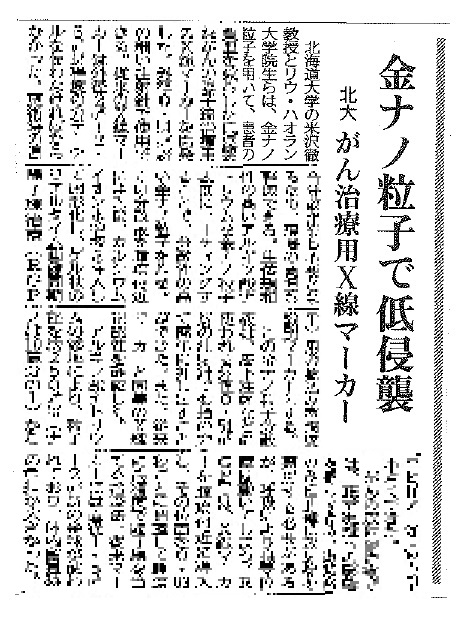
- Wei Jian Sim, Mai Thanh Nguyen, Zixuan Huang, Soorathep Kheawhom, Chularat Wattanakit, and Tetsu Yonezawa
“Efficient iron-cobalt oxide bifunctional electrode catalyst in rechargeable high current density zinc-air battery”
Nanoscale, 14(22), 8012-8022 (2022).【RSC】(IF=7.790)
DOI : 10.1039/D2NR01258H (Published (web) 4 April 2022)
【国際共同研究】【JST】

Abstract: Iron-cobalt (FeCo) oxides dispersed on reduced graphene oxide (rGO) were synthesized from nitrate precursors in loading levels from 10 wt% to 60 wt%. These catalysts were tested in lab-scale zinc-air batteries (ZAB) at a high current density of 100 mA cm-2 of cathode area for the first time, cycling between 60 min of discharging and 60 min of charging. Optimum loading level for the best ZAB cycling performance was found to be 40 wt%, at which CoFe2O4 and CoO nanocrystals were detected. Discharge capacity of at least 90% was maintained for about 60 cycles with FeCo 40 wt%, demonstrating superior stability over the amorphous FeCo oxides in FeCo 10 wt% despite similar performance at electrochemical tests. At high current density of 100 mA cm-2, OER catalytic activity was found to be the limiting factor in ZAB’s cyclability. The discrepancies between the ORR/OER catalytic activities by electrochemical test and battery cycling test results highlight the role and importance of rGO in improving electrical conductivity and activation of metal oxide electrocatalysts in high current density conditions. The departure of battery cycling test results from traditional electrochemical tests results suggests that electrochemical tests conducted at low current densities may be inadequate in predicting practical battery cycling performance.
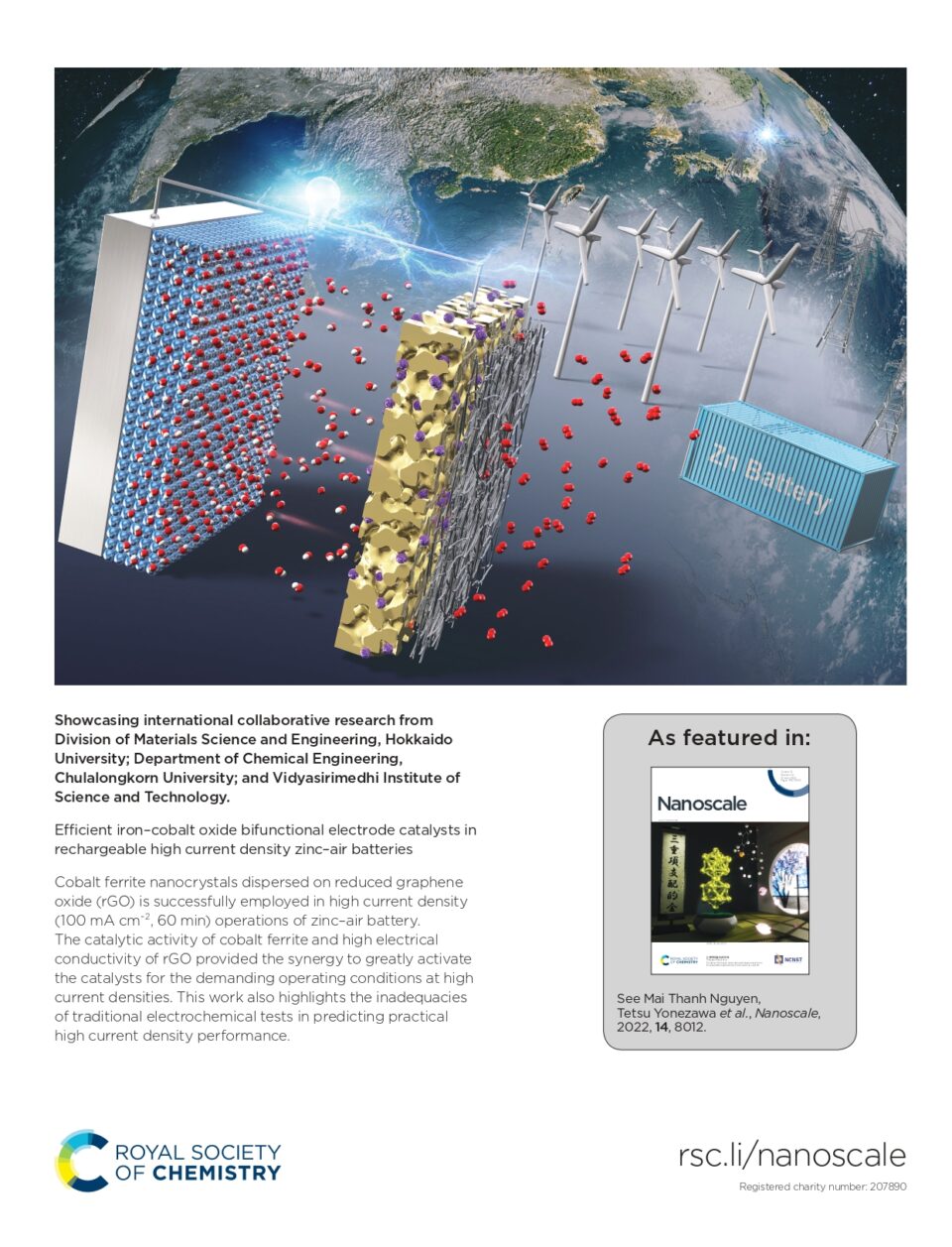
- Rintaro Tokura, Hiroki Tsukamoto, Tomoharu Tokunaga, Mai Thanh Nguyen and Tetsu Yonezawa
“The role of surface oxides and stabilising carboxylic acids of copper nanoparticles during low-temperature sintering”
Materials Advances, 3(12), 4802-4812 (2022).【RSC】【Open Access】
DOI: 10.1039/D1MA01242H (Published (web) 5 April 2022)
【国内大学間共同研究】【ナノテクプラットフォーム】【科研費】

Abstract: This article provides a detailed discussion of hexanoic-acid-stabilised copper nanoparticles with an average diameter of ~80 nm prepared from cupric oxide micro-powders for low-temperature sintering applications. The obtained fine particles were dispersed in dipropylene glycol using a bead mill to obtain a stable paste containing 50 wt.% copper. Sintering experiments at temperatures in the range of 120 – 250 °C were performed under a nitrogen or 3%H2-N2 gas flow. The lowest resistivity, approximately three times that of bulk copper, was obtained at 250 °C. These particles exhibited good conductivity upon sintering under nitrogen only. Hexanoic acid contributed to the acceleration of sintering by removing the Cu64O oxide layer of the particles and activating the surface. The dispersed copper paste and the copper layer after sintering were observed using SEM.
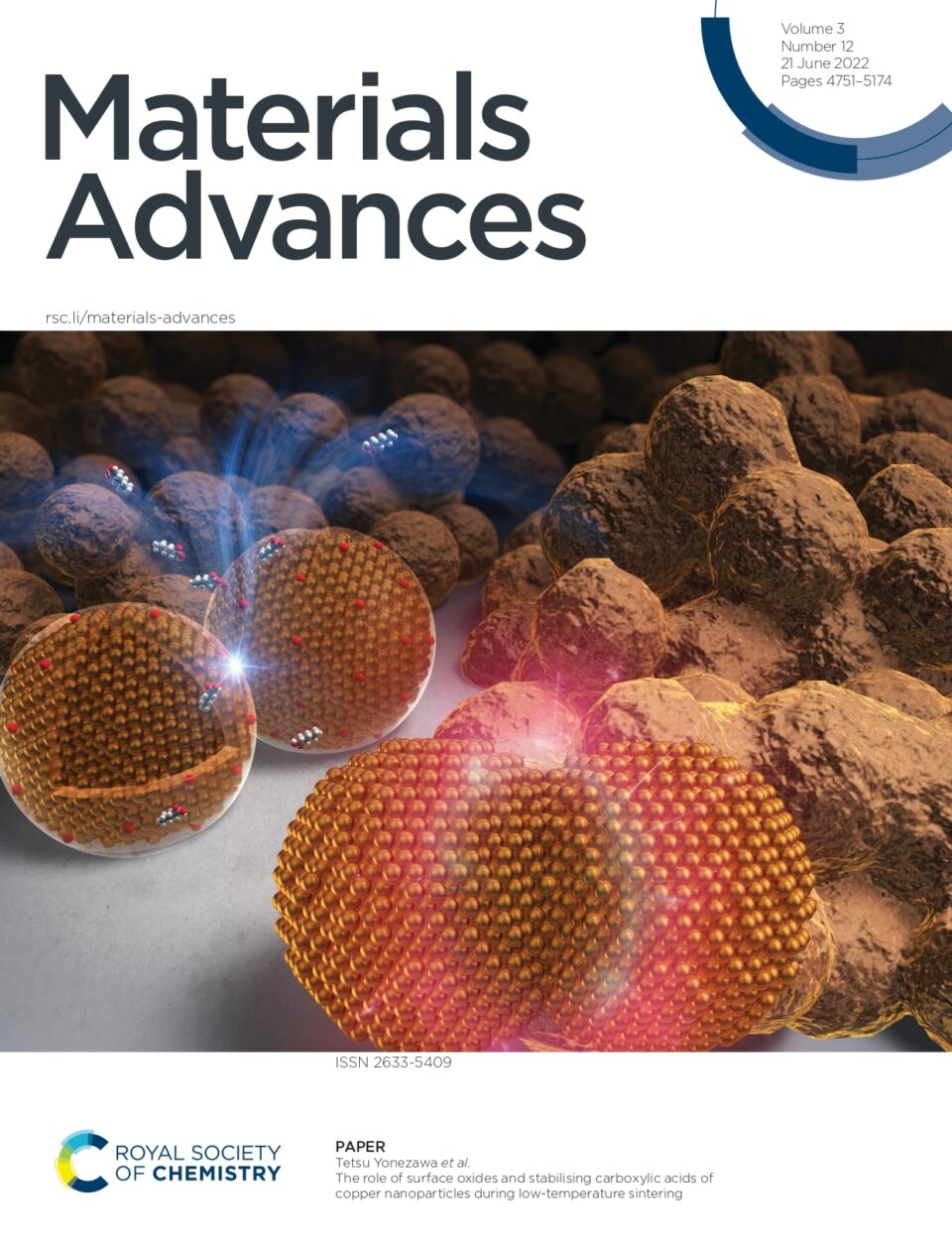
- Mai Thanh Nguyen, Tatsuki Muramatsu, Soorathep Kheawhom, Chularat Wattanakit, Tetsu Yonezawa
“Impact of Morphology and Transition Metal Doping of Vanadate Nanowires without Surface Modification on the Performance of Aqueous Zinc-Ion Batteries”
Bulletin of the Chemical Society of Japan, 95(5), 728-734 (2022). 【CSJ】
DOI:10.1246/bcsj.20210427 (Published (web) 18 March 2022)
【国際共同研究】【JST】【CEED学生派遣】

Abstract: This research evaluates the impact of nanowire morphology and transition-metal doping to vanadium oxides as the positive electrode material on the performance of rechargeable aqueous zinc-ion batteries. It is found that both the wire morphology and Cu doping enhanced the cycle stability and specific capacity of the cathode. The improvement is ascribed to the wire morphology and Cu doping for attaining more mechanical stability, less morphology change, and parasitic reactions, and more facile Zn2+ insertion/extraction.
- Kai Ikeda, Haoran Liu, Naoki Miyamoto, Mai Thanh Nguyen, Hiroki Shirato, and Tetsu Yonezawa
“Preparation of Biopex-supported gold nanoparticles as a potential fiducial marker for image-guided radiation therapy”
ACS Applied Bio Materials, 5(3), 1259-1265 (2022).
DOI: 10.1021/acsabm.1c01271 (Published (web) 17 February 2022) 【ACS】
【学内部局間共同研究】【医工連携】【AMED】【JKA】

Abstract: Image-guided radiation therapy (IGRT) has emerged as a promising technique for cancer treatment to improve radiation precision and accuracy, thereby reducing the treatment toxicity and optimizing therapeutic efficacy. In IGRT, fiducial markers are required to be inserted near the tumor to get the spatial information of the tumor. Currently used metal fiducial markers with large sizes would be highly invasive; therefore, it is critical to develop minimally invasive alternatives to these markers. In this work, an injectable marker based on Biopex-supported Au NPs with adequate radio-opacity for X-ray visualization was developed. Biopex can function as a substrate for the growth of Au NPs and avoid excessive reaction-induced aggregation and precipitation. The self-curing property of Biopex prevents the leakage and elimination of isolated Au NPs, enabling long-term X-ray observation and radiotherapy. The effect of Biopex amount, gold precursor concentration, and reaction time were evaluated. The visibility of samples prepared by the optimized formula was also examined. The developed Biopex-Au NPs could be injected through a 21 G needle and exhibit great visibility in the X-ray visualization test, showing great potential as a fiducial marker for image-guided radiation therapy.
- Min Jia Saw, Mai Thanh Nguyen, Yuji Kunisada, Tomoharu Tokunaga, and Tetsu Yonezawa
“Anisotropic Growth of Copper Nanorods Mediated by Cl– ions”
ACS Omega, 7(8), 7414-7420 (2022).
DOI: 10.1021/acsomega.2c00359 (Published (web) 16 February 2022) 【ACS】【Open Access】
【大学間共同研究】【ナノテクプラットフォーム】【科研費】【JST】
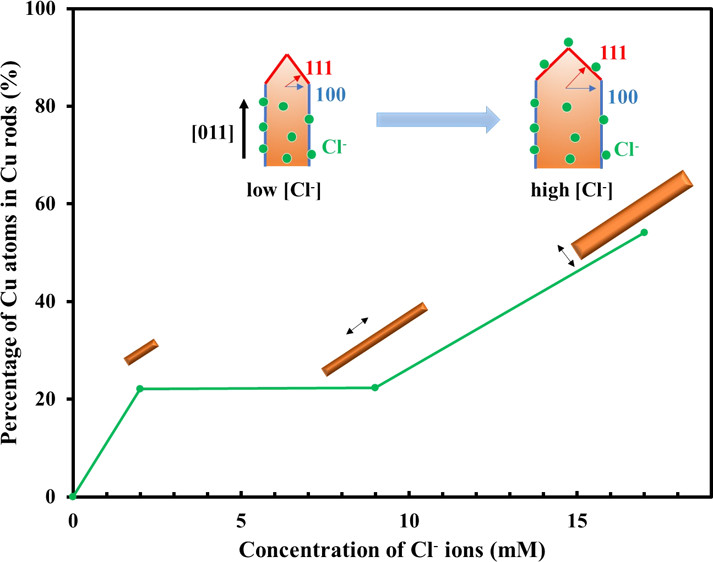
Abstract: Anisotropic growth to form Cu particles of rod and wire shapes has been obtained typically in a complex system that involves both organic capping agents and Cl– ions. However, the sole effect of Cl– ions on the formation of Cu wires has yet to be fully understood, especially in an organic system. This present work determines the effect of Cl– ions on the morphologies of Cu particles in an organic phase without any capping agents. The results revealed that anisotropic Cu rods could be grown with the sole presence of Cl– ions. The rods have the (011) facets as the long axis, the (111) facets as the tip, and the (100) facets as the side surface. By increasing the Cl– ion concentration, more Cu atoms contributed to the formation of Cu rods and the kinetic growth of the length and the diameter of the rods varied. This suggests that Cl– ions have preferential adsorption on the (100) Cu surfaces to promote the anisotropic growth of Cu. Meanwhile, the adsorption of Cl– to the (111) and (100) surfaces at high Cl– concentrations regulates the relative growth of the particle length and diameter.
- Haoran Liu, Kai Ikeda, Mai Thanh Nguyen, Susumu Sato, Naoki Matsuda, Hiroki Tsukamoto, Tomoharu Tokunaga, and Tetsu Yonezawa
“Alginate-stabilized Gold Nanoparticles Prepared in Microwave-induced Plasma in Liquid Process with Long-term Storage Stability for Potential Biomedical Applications”
ACS Omega, 7(7), 6238-6247 (2022). 【ACS】【Open Access】
DOI: 10.1021/acsomega.1c06769 (Published (web) 9 February 2022)
【大学間共同研究】【AMED】【JKA】【ノーステック】
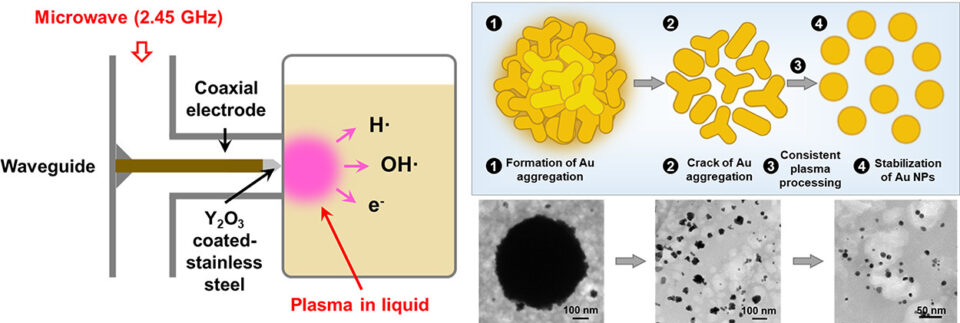
Abstract: A one-step preparation of alginate-stabilized gold nanoparticles (Au NPs) using the microwave-induced plasma-in-liquid process (MWPLP) was reported. Effects of alginate with various concentrations on the preparation and properties of the synthesized Au NPs, including reaction rate, morphology, size, and optical absorption property, were studied. The introduction of alginate (1) accelerated the reaction rate, (2) prevented aggregation and precipitation due to long time discharge in MWPLP, and (3) provided long-term colloidal stability. An abnormal size change (from large to small) of Au NPs during particle growth, which was opposite to the typical change in bottom-up chemical reduction, was observed and a possible mechanism was proposed based on the dynamical and thermodynamical instability of particles during growth. The strategy of drying and redispersion of Au NPs in alginate solution was also studied. The drying and redispersion process had an imperceptible effect on the Au NPs. As a consequence, this strategy might be an effective technique for the long-term storage of Au NPs and other metal NPs. The alginate-stabilized Au NPs without the addition of toxic reducing or stabilizing agents can be appropriate to biomedical applications.
- Masamu Nishimoto, Rintaro Tokura, Mai Thanh Nguyen, and Tetsu Yonezawa【Review Article】
“Copper Materials for Low Temperature Sintering”
Materials Transactions, 63(5), 663-675. (2022).
DOI: 10.2320/matertrans.MT-N2021004 (Published (web) 18 March 2022)
【研究室内研究】【JST】【科研費】
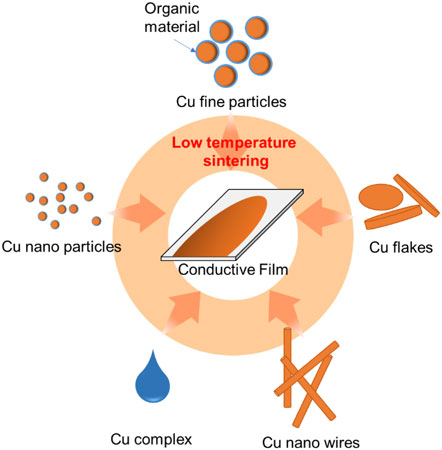
Abstract: In this review paper, recent studies on low-temperature sintering strategies of copper materials for conductive layer preparation have been summarized. Coinage metals, gold, silver, and copper have been used as materials for conductive inks and pastes for printed electronics. Copper is a highly electrically and thermally conductive material that can be used in electronic circuits and die-attach materials. Recently, copper-based inks/pastes have gained significant attention of researchers and industries as conductive materials. However, copper is readily oxidized under air, especially, at the nanoscale, and copper particles may catch fire because of the rapid oxidization. To overcome this issue, copper nanoparticles and fine particles are coated with organic molecules which act as insulators after sintering. Some interesting surface treatments or activation strategies have been investigated in this regard. In this paper, different perspectives on the applications of copper in conductive and die-attach materials have been presented.
- Rintaro Tokura and Tetsu Yonezawa【Review Article】
“Strategies for achieving low temperature sintering of copper inks and pastes for printed electronics”
Accounts of Materials & Surface Research, 7(1), 18-26 (2022).
PDF
【研究室内研究】【JST】
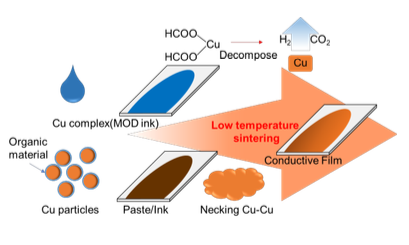
Abstract: Printed electronics (PE) attracts much attention from researchers and engineers as a more simple and more cost-effective alternative process than photolithography to prepare conductive electrical circuits on substrates. In this account paper, we present various strategies for low-temperature thermal sintering using copper nanoparticles, copper microparticles, and metal-organic decomposed copper complexes (MODs). Nanoparticles can be sintered at low temperatures due to size effects. In contrast, copper particles are inferior to nanoparticles in terms of low-temperature sintering, but this can be achieved by modifying the surface with an organic substance that promotes sintering or by removing the oxide layer. And MOD ink can obtain metallic copper from organic copper complexes at around 130 °C. All the methods produced sintered films with low resistivity from room temperature to below 200 °C, suggesting the possibility of using flexible and conventional polymer substrates in PE.
総説・解説
- Mai Thanh Nguyen・Tetsu Yonezawa
“Structure of Bimetallic Nanoparticles Synthesized by Sputter Deposition onto Liquid and Their Catalytic Properties”
C & I Communications, in press. - 米澤 徹・渡部 蓮
「銅微粒子のコアの微細構造制御による低温迅速焼成」
鉱山、75(6), 175-182 (2022). - 米澤 徹・塚本宏樹
「有機酸被覆銅微粒子を利用した低温焼成技術」
スマートプロセス学会誌,11(6), 272-277 (2022). - 戸倉凜太郎・米澤 徹
「高分子化合物を利用したプリンテッドエレクトロニクス用の銅微粒子ペーストの展開と導電性被膜形成」
(2022)
シーエムシー出版 - 米澤 徹
「金属微粒子・ナノ粒子の構造制御と濃厚分散系の構築」
(新領域研究グループ「分散凝集の学理構築への科学と技術戦略」紹介)
化学と工業, 75(2), 104 (2022).
